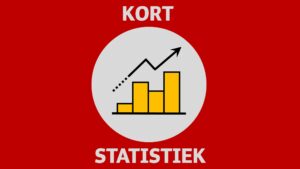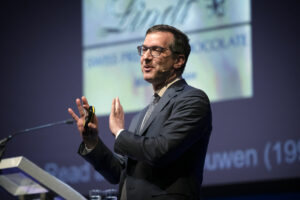With his research into savings and self-control problems, David Laibson is one of the founders of contemporary behavioral economics.
David Laibson’s groundbreaking research focuses on people’s inner struggle when having to make intertemporal choices (box 1). About his 1994 thesis (Laibson, 1994), in which he formalizes the work of the psychologist George Ainslie, The New York Times (2001) wrote: “In the histories of economics still to be written, the spring of 1994 will almost certainly be flagged as momentous.” Not much later Laibson is appointed as professor at Harvard; the first one to have actually trained as a behavioral economist (The New York Times, 2001).
Box 1: Hyperbolic discounting
In his best-known work, Laibson (1997) presents a model of quasi-hyperbolic discounting (i.e. present bias): people prefer instant gratification approximately twice as much as they value rewards in the future. So, people prefer a small reward today rather than a much larger reward in a few days time. As a consequence, people take decisions they regret later on. This explains for example why society encourages the possession of illiquid assets, such as pensions, durable goods and housing. For society, these illiquid assets provide substantial long-term benefits. The accumulation of these illiquid assets should be subsidized or otherwise encouraged by the government because present-biased consumers won’t have the patience and self-control to accumulate them on their own.
Laibson just stepped down as dean of the Harvard economics faculty. At the anniversary congress of the Netherlands Authority for Consumers & Markets, I spoke to Laibson about his involvement in the Behavior Change for Good initiative, the role of the government in financial planning, and about the potential of genoeconomics. On June 3rd, he will give the keynote lecture at the Maastricht Behavioral and Experimental Economics Symposium.
You’re one of the people involved in the Behavior Change for Good initiative. What makes this project special?
“The aim of this project is to bring together a community of researchers, and to connect them to companies on a platform, in order to use insights from economics and psychology to change behavior. Because of the project, new ideas and collaborations will develop, as various professions come together – economists, psychologists, doctors, marketeers – brainstorming, creating new sparks and getting ideas going.
In addition, the usual binary relationships between an individual researcher and a firm are normally very costly: it takes a lot of time and money to set up a single study. With the Behavior Change for Good initiative, a negotiation with one company means that dozens of research teams can use that company’s consumer base. Because of the scope of this collaboration it is then much easier to find corporate partners.”
Do you already see any results of that project?
“Absolutely. For example, the first meeting, also recorded in a Freakonomics podcast (Freakonomics, 2018), acted as a catalyst for my study on facilitating laptop use in the classroom, which I didn’t think would become a formal study. At the beginning of the year, students are offered the choice on which side of the lecture hall they want to sit: the side where everyone can use a laptop, or where laptops aren’t allowed. The first meeting of the Behavior Change for Good initiative yielded enough momentum, so that we could convert an idiosyncratic idea, which I was developing only in my own classroom, into a randomized controlled trial (RCT).”
Behavior Change for Good is a brilliant initiative of course, but in one way or another it also reminds me of the scandal around Cambridge Analytica (CA) and Facebook: insights from psychology and behavioral economics are applied to influence beliefs and behavior. How did we actually go from simple nudging to Cambridge Analytica?
“It is important to emphasize that I don’t know all the details of that story, but in two ways I feel a great distance between my world and that of Cambridge Analytica.
In the first place, CA obtained its data from a researcher who did not work ethically. He collected and scraped data from Facebook in a way that was inconsistent with our communities’ values as researchers, and then handed the data on to a company that used them to try to sway elections. That is not creating social science knowledge. A tenet of everything we do, is that we only do a study if we believe that everyone in it will experience a benefit.
The second reason is that I doubt whether the method used by CA actually works. Targeting, in the form of marketing, is clearly effective. People with a ten year old car and money in the bank often buy a new car. So, if a car company knows who they are, it can use its advertising budget more effectively. But the kind of targeting CA was engaged in was different. They divided the population into segments, based on a psychological profile, and then approached a person on the basis of that profile with a message that would prompt them to a different voting behavior in the presidential election. I cannot think of a study that shows that this really works, and assume they made this up without testing it. The claim that they have influenced the elections is probably mainly due to marketing by the company.
But of course, you can put those distinctions aside and say that there is a similarity: behavioral science is the science of how to facilitate actions which would otherwise not occur. As a behavioral scientist, I nudge people to save more for their retirement, I try to convince people to get their flu shots, take their medication or visit the doctor. But it can also be used by firms to get people to buy products they don’t want or need, and by political organizations to get people to vote for candidates they wouldn’t otherwise support. All science is a two-edged sword.
To a certain extent I would argue that what we are doing is bringing back the notion that entire industries are based on the influencing of behavior. If you go back to the nineteenth century, you will probably discover that firms already used the default option on a large scale. But economists were surprised when, early on in 2000, they learned how powerful default options are. Much of our research is focused on measuring things that have been known to companies for a long time, and have always been true, but were just not appreciated by economists.”
How is it that economists have forgotten those things, and that awareness is returning now?
“That is a slightly depressing story. What happened is that someone like Adam Smith was a prolific observer of human behavior: of the psychological, the sociological, the economic and the political. In the eighteenth century he described a world that was rich and complicated. And, for the next hundred years, economists continued to describe this rich world.
But at the end of the nineteenth century it suddenly became clear that we could start a kind of new science that would actually be able to prove very general properties if we stripped it down to three basic assumptions. The first people who did that, Walras and Samuelson, knew that these models were illustrative and knew the boundaries of mathematical formalism. Samuelson acknowledges the gaps between his mathematical formalism and the behavior of actual consumers (for example, see the final pages of his landmark paper ‘A note on measurement of utility’ (Samuelson, 1937)).
But then, economists developed a sort of cult-like approach. And by 1980, rational behavior had become a good approximation of human behavior, and you were labeled irresponsible or a lunatic if you claimed that people were not rational. I believe that had a lot to do with the beauty of mathematics which blossomed during this period, so that many economists fell in love with formalism. It became a sort of IQ contest to see who is smart enough to explain the behavior of a completely rational agent with a mathematical model.
And then suddenly, in the mid-eighties, everyone believed that the rational actor model is the best model. And that it was so good, that other models were no longer serious competitors. Across the social sciences, the recognition now returns that models can be wrong and that we should not take them too seriously, because the world is complicated.”
Your research into how people make choices is still developing. For instance, in the Richard T. Ely lecture you talked about your new idea on exploitation of naive, short-sighted consumers and employees (AEA, 2018; Laibson, 2018). What is the new insight here?
“Whether consumers are exploited depends on the way they make a decision. And because people decide in different ways, depending on the type of decision and the information available, the outcome – whether there is exploitation or not – might be different.
The first way of deciding is by having a theory as to one’s own behavior. Suppose I invite you to come and work for my firm, with the promise that you will get a million dollars a year if you work seventy hours a week. That is a great offer, but only after you have been working for a while you discover that it is impossible to work so many hours, because life is busy. In the end you only work forty hours a week, and I only pay you one hundred thousand dollars. So, that million was a bait-and-switch, because as a firm I know that in fact nobody will be able to work that hard, and no one will ever get a million dollars. Naive consumers with present bias who think in such a way will therefore be exploited.
However, – and that is the new point here – maybe people don’t approach it in this way. A second way of approaching an employment relationship is reputationally. In that case you don’t have a theory about how hard you will work at the company, but you talk to people who are already working there in order to ask them about their experiences. Then you may get a more accurate answer. And companies that attract employees on the basis of their reputation have totally different incentives then, for instance to actually treat and pay their employees well.
It depends on the market you are studying whether you are dealing with companies that use exploitation or reputation. A university like Harvard is clearly in the business of reputation. Potential employees look at the university’s ranking and assume that the compensation scheme is good. On the other hand, if someone is looking for a gym in which to exercise, it’s much harder to find reputational information, and therefore people approach it with a theory. As a result, exploitation will often be the outcome.”
And what if it’s not the firm that benefits, but if one group of consumers benefits from the other?
“An example of this is the banking system, which can have the unintended consequences that money flows from low-income to high-income people, for example because people with low financial literacy and low incomes do not pay their credit card debts in time, while sophisticated consumers do. This is an additional source of inequality that is disadvantageous from the utilitarian social planner’s perspective.
This is not really economics anymore, because now we’re talking about ethics. A libertarian would say that the rational consumer should enjoy the benefits of his rationality and the less sophisticated consumer should face the consequences of his lesser sophistication. But, like most economists, I am a utilitarian. And that means that public finances should maximize overall social welfare, by transferring wealth from the rich to the poor in order to reduce inequality. Except when inequality creates large social distortions.”

Isn’t that unfair to a rational agent? He’s been saving money his entire working life, sees that the short-sighted person goes on holiday twice a year, and then he has to hand over his wealth.
“That’s not the way to do it. The solution is not to transfer a lot of wealth between households in order to subsidize people that live lavishly above their means. What we should be doing is create more compulsory savings. We’ve just written a paper about that (Beshears et al., 2017).”
In the Netherlands, there currently is a discussion on how you can better spread illiquid lifesavings over the lifetime, because it often goes into pensions and homes. Don’t you think that higher compulsory savings will create even more illiquid assets?
“I would urge people to be careful about reforming social security and the pension system. Not all people can be relied upon to spend money rationally and wisely. Some may do that, others not. It is instinctive to say that you should give people more freedom, but half of the people will use that freedom in a way that is self-defeating. The result is that we will end up with a lot of people who have no money anymore, which leads to a frustrated society. The best way to avoid that is to force people to save more during their working life, and to compel them not to spend everything the day they retire.”
Not subtle influencing, but a simple obligation.
“Sometimes I believe in strong paternalism. Sometimes we need to set not only a default, but a true restriction.”
Is the European social security model in this case an example or a nightmare?
“Europe, and to a lesser extent the United States, have both made a terrible mistake by promising more social benefits than they can afford. So, Europe is at the same time a success story, because there are more mandatory savings and is probably closer to the socially efficient model than we are in the US. But also a nightmare, because there are generally too many promises, and the resources that are put aside are insufficient.
This is partly because the whole system was based on the wrong assumptions: faster population growth – a very strong assumption with far-reaching consequences – and unrealistic returns. Together, this now leads to a worldwide pension crisis and a health care crisis. We are running towards a cliff and the longer we wait to fix that, the harder the young generation is going to get hit.”
You are now doing research in a field that is still in its infancy: genoeconomics. For an outsider, the promise doesn’t seem to be realized yet, for instance the explanation on Wikipedia is limited to: “Genoeconomics is a field of protoscience that combines molecular genetics and economics. Genoeconomics is based on the idea that a person’s financial behavior could be traced to their DNA and that genes are related to economic behavior.” And it concludes with “Some minor correlations have been identified.” That doesn’t sound very promising, does it?
“I understand why it says that, but that only weak correlations have been found is a misunderstanding. Let me explain this.
A human genome contains an organism’s complete genetic composition. Such a genome consists of 46 chromosomes with roughly six billion base pairs; half of the mother, and the other half of the father. Of these, around five million base pairs account for much of the variation in the human population. Most of those base pairs do not have any explanatory power as to who you are and what is going to happen in your life. Huntington’s disease, where one base pair deviates, is really an exception. In general, the most powerful base pairs explain at the most 0.02 percent of the coefficient of determination (R2). So, those are indeed weak correlations.
But if you make an index of a million base pairs that matter, assigning a weight to all of them, and then make a prediction on the basis of it, this will yield an R2 of 0.12 (implying a correlation of 0.35). And as the samples increase, the R2 moves towards twenty percent. There is a paper coming out in Nature Genetics, where I am one of the eighty co-authors, that reports these findings (Lee et al., 2018).”
If you can partially predict behavior on the basis of genetics, can you also determine which characteristics have been determined by talent and which by education, so as to contribute to the nature-nurture debate?
“You have to be careful not to interpret this through a causal lens, and realize that it’s in the realm of prediction mostly. The fact that a base pair predicts something does not mean that it is purely nature. Because the base pair interacts with the environment. For example, if a base pair that predicts competitiveness is a good predictor of school success in France, which has a competitive schooling system, this does not mean that the same base pair also will be a good predictor in the Netherlands.
In addition, for the correlations between different genetic variants, it is also important to know how the genome is cut up and passed on from parent to child in different ancestral populations. For example, a certain base pair A may be responsible for a specific causal relationship. However, the way in which it has been passed on from generation to generation has led base pair A to be correlated with base pair B in the population of Iceland, whereas in the population of Uganda these are not correlated with each other. It thus appears in Iceland that base pair B has a causal relationship, whereas this is not the case.”
What will this ultimately lead to?
“In a few years’ time, genetic information will drastically reduce the costs of carrying out many studies in medicine and social sciences. Normally, control variables are added to RCTs to soak up noise. But if noise can also be reduced with genetic information, this means that smaller samples can be used. I think that studies with a 25 percent smaller sample size can be done. This is especially important for costly research; collecting genetic data costs only about fifty dollars per person.”
A regression that says y = C + b1 × explanatory variable + b2 × genetics?
“Yes, that paper will be written within the next few years.”
References
AEA (2018) AEA Richard T. Ely lecture: competition, equilibrium, freedom, and paternalism. Video at www.aeaweb.org.
Freakonomics (2018) How to launch a behavior-change revolution. Podcast, episode 306, at freakonomics.com.
Laibson, D. (1994) Hyperbolic discounting and consumption. Thesis at dspace.mit.edu.
Laibson, D. (1997) Golden eggs and hyperbolic discounting. The Quarterly Journal of Economics, 112(2), 443–478.
Laibson, D. (2018) Private paternalism, the commitment puzzle, and model-free equilibrium. American Economic Review Papers and Proceedings, 108, 1–21.
Beshears, J., J. Choi, C. Clayton, et al. (2017) Optimal illiquidity. NBER Retirement Research Center Paper, NB 17-02.
Lee, J.J., R. Wedow, A. Okbay et al. (2018) Gene discovery and polygenic prediction from a genome-wide association study of educational attainment in 1.1 million individuals. Nature Genetics, 50, 1112–1121.
Samuelson, P. (1937) A note on measurement of utility. The Review of Economic Studies, 4(2), 155–161.
The New York Times (2001) Following the money, but also the mind. Article at www.nytimes.com.
Auteur
Categorieën





